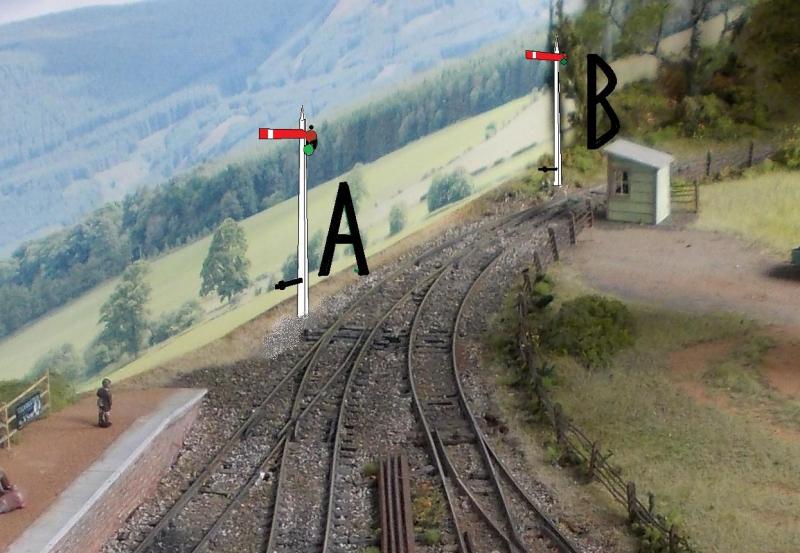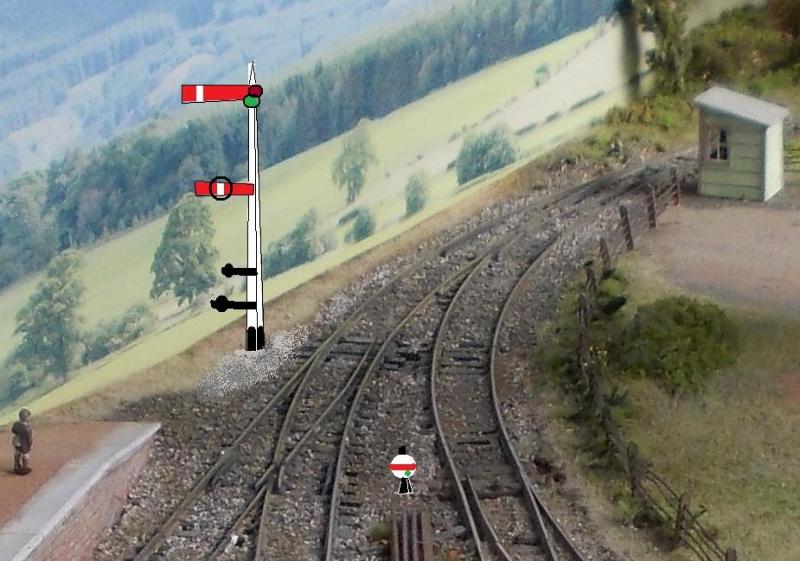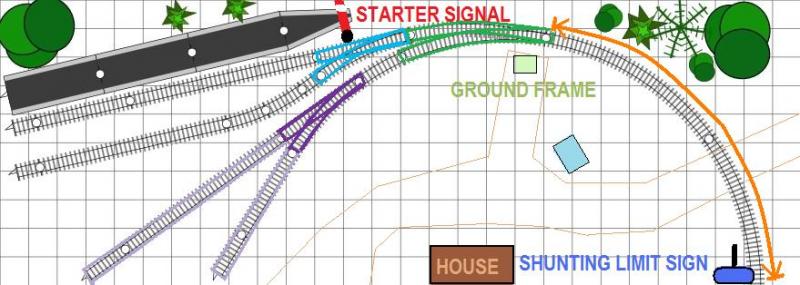What signal do I use ??
Posted
#194329
(In Topic #10809)
Banned
Placing a 'starting' signal on Linden Ford
I have the Ratio kit No. 477, LNWR Square Post Signals. Now this kit can build 4 different signals by the look of what's in the box. I intend using one of these signals as a starting signal, positioned between the end of the platform and the small ground frame/hut (pos A), or just behind the point to the yard, on the other side of the ground frame (pos. B). My question is, if anyone can answer this, which one do I use for a starting signal and where do I position it ?I guess that the starting signal would be similar to what I have drawn below ?? :hmm
Here is a pic of the proposed positions, A and B…

Cheers, Gary.
Posted
Site staff

B could be the distant for the next block, or you could have a combined starter and distant at A.
Ed
Posted
Banned
I'm thinking that the distant signal would be off the board. I need to use the section of curved track as part of the shunting puzzle. I do need to put a sign 'LIMIT OF SHUNT' near the level crossing.
Cheers, Gary.
Posted
Full Member
(1) A short signal on ,or at the very end of , the platform. This would be the starter for passenger trains
(2) An advanced starter at your limit of shunt location. This would then mean that the goods sidings could be controlled by ground signals or quite reasonably hand signals as all the points are close to the ground frame. All shunting would take place within station limits
I suggest a signal on or near the platform because location A doesn't look right in relation to the point
Regards
Posted
Full Member
I would bring the starter even closer to the platform end. Some were even cut into (and appeared to sprout from) the ramp which can add a little modelling interest if you're prepared to be brave.
Another option is to leave the starter at position A and equip it with a subsidiary arm (perhaps a "ringed" arm) acting as the starter from the loop. Under local working rules clearing that might only require the line ahead to be available to the Limit of Shunt board; it does not have to give a clear line indication for the section ahead.
The starter is used to indicate to all staff that it is clear for a train to start from the signalled track. It should not be placed where the meaning might be misinterpreted as applying to a different track.
Your sidings / loops should be controlled by miniature (ground) signals appropriate to your era and placed sufficiently far back that anything standing at them does not foul any other line. If your train plus loco will be longer than the platform this can be controlled by the use of a repeater arm at position B. It's not ideal but was the solution used in some locations where space was tight.
You should definitely place a limit of shunt board along your main line in a position where any move out of the sidings is going to be clear of all points. This might be off your scene.
Ideally you would have an approach signal also equipped with miniature arms / discs to control direct access to all four roads but this can be assumed to be off scene. There is no need to use fixed signals for moves entirely within a "limit of shunt" if the interlocking allows such moves to be made by line of sight.
 Last edit: by Gwiwer
Last edit: by Gwiwer
Posted
Full Member
.

B at limit of shunt with an added distant arm. ground signals for the siding, if the run round loop also has a platform then it should probably have its own starter, it's not obvious from the photo if the station is a through or terminus. A catch point on the siding exit (unless you have them on both sidings out of picture)
Cheers MIKE
I'm like my avatar - a local ruin!
I'm like my avatar - a local ruin!
Posted
Banned
John, I hear what you are saying, but being a shunting plank, it does have it's certain requirements for exceeding shunting limits !
Rick, your answer is very informative. The 'ringed' arm signal, is that the one with the red signal arm and a white ring on it, as used by the LNWR and GWR ?? As like the one I have drawn in here, with the siding ground signal on the right :

Mike, now that's one type of signal I have never seen, but could be useful in blind spots as you suggested.
I ended up reading Nick's (pnwood) thread 'Signalling Help Needed' under Signals. I found this quite interesting to say the least. One aspect of branchline terminus running is that there would generally be one loco in use at the terminus at any one time, sometimes two, but not that often. As Linden Ford has no real loco facilities, the train entering Linden Ford would be working with the 'token' system, obtained from the next station or junction up the line (off the board). Most of the yard movements on Linden Ford would be carried out by the shunter/driver of the particular train arriving/in use at Linden Ford.
In the diagram below, I have drawn the 'starter signal' at the base of the platform and a 'shunting limit sign' at the edge of the baseboard, across the railway crossing. Yes, I realise that the 'shunting limit' is further down the line than anticipated, but that is because I need this length of track to hold a loco and 5 x wagons. This area has an orange arrow drawn in. I have also coloured the points green, blue and purple.
The purple point would be thrown by hand by the shunter, whereas the green and blue could/would (?) be controlled by the ground frame.

Now, two things…
1. If both the green and blue point are operated by the ground frame, would the signal at the base of the platform need to be moved up to be parallel to the toe of the blue point, using a bracketed signal to control both the platform and the goods siding (parallel with platform) ?
2. Or should I move the signal closer to the platform and use a start signal with a lower ring signal like I drew above ?
Another option is to use the second suggestion above, and use the discretion of the shunter to control train movements in conjunction with the ground frame signalman ?? I believe that many BLTs' didn't always have ground signals.
:hmm This signalling is quite confusing… Another aspect I read in Nick's thread was that railway companies used different methods of signalling/safe working at different locations to control the individual needs of that particular location… :???:
Oh my god…, what did I lead myself into…?? :oops:
I will say that I found this great site for all types of signals : http://www.railsigns.uk/home.html
Cheers, Gary.
Posted
Full Member
I was originally going to suggest a token but suspected you wanted to use the signal kit you had.
On reflection I think attempting to correctly signal the branch with a starter and all the attendant ground discs will look too complicated and cluttered
I think that the best and easiest solution is to say that the branch to Linden Ford is operated on the "single engine in steam" rule with entry to the branch line controlled by a staff or token………….result….no signals at all.
This would mean that only one loco could appear at any one time. Technically if you had a loco shed you could have a second stationary loco but I think that would be unrealistic for a branch of that size.
You could pre-empt any questions at the exhibition by adding the Monty Models figure of a porter holding a token

Regars
Posted
Full Member
Posted
Banned
Exactly as you have it Gary
Another words, don't change or add anything, I'm guessing…??
Cheers, Gary.
Posted
Full Member
Did you get your signalling sorted? I think Rick is on his way to the UK.
If you are going to have more than one loco on the layout the I would suggest having a bracketed signal exactly in the position you have shown in your last drawing. The signal on the post would be the starter for the platform………a right hand bracket bearing a lower post would have a ringed signal on a shorter board to control the exit from the goods siding. I agree all the other points to be controlled by hand signals
If only one loco will appear at any one time then……single engine in steam as per my last post
Hope this helps
Regards
1 guest and 0 members have just viewed this.

